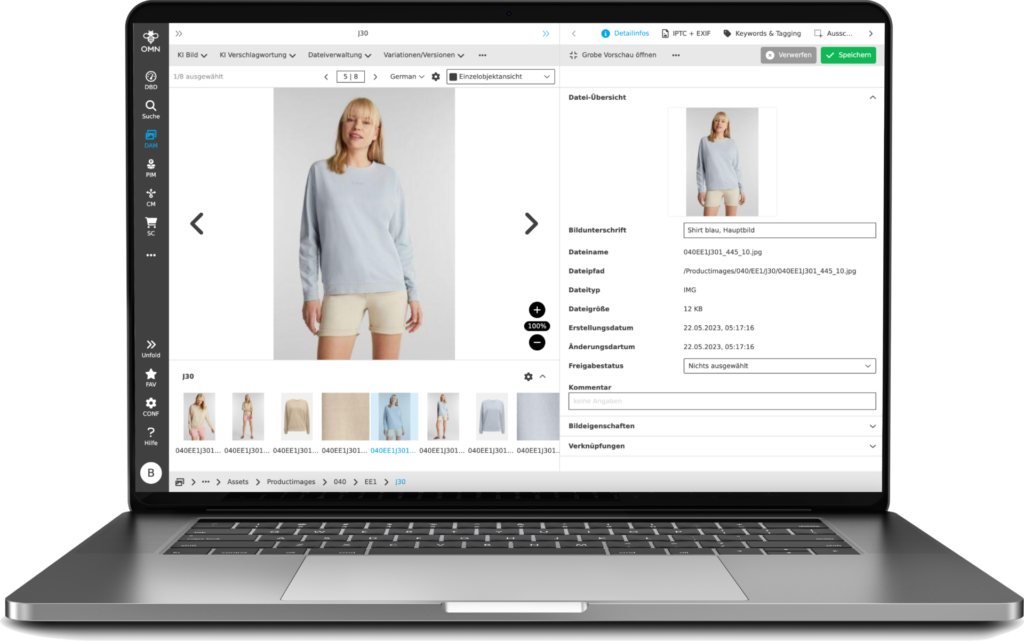Cloud Storage for DAM
Digital Asset Management
The digital revolution has led to an exponential growth in digital content that organisations need to manage. This is where Digital Asset Management (DAM) systems come in to bring order to the chaos. The implementation of DAM systems as a cloud storage solution has proven to be particularly effective. In this blog post, we look at the benefits and important considerations that should be taken into account when using cloud storage for DAM.

What is Cloud Storage?
Cloud storage, often simply referred to as “the Cloud”, is an external storage space that is provided via the Internet. The storage space is located on remote servers and is accessible online via Internet-enabled devices. The cloud is not only used for data storage, but also for the provision of computing power and the operation of applications, platforms and infrastructures. The common service models within the cloud include:
- Software as a Service (SaaS): Provision of a software application. Operation and maintenance is carried out by the provider.
- Plattform as a Service (PaaS): Provision of a platform specifically for programmers to develop, run and manage their own applications.
- Infrastructure as a Service (IaaS): Provision of a data centre infrastructure such as storage, computing or network resources.
Advantages of Cloud Storage for DAM
DAM is the abbreviation for Digital Asset Management. This refers to the central management and provision of assets, i.e. all visual content such as images, videos, documents, graphics, presentations and audio. The systems that support this on the software side are called DAM systems. In addition to the management and provision of assets, the main tasks of a DAM system also include the import and channel-specific export.
You can either purchase a DAM system with a one-off purchase price or rent it as a service for a monthly fee. The first case is referred to as an on-premises solution, while the rental variant is known as SaaS (Software as a Service) in the cloud. Either way, both variants offer you a central source for storing, organising and managing digital assets. The difference is the hosting environment, whereby with a SaaS solution the DAM provider takes over the hosting (either itself or outsourced to a cloud service provider). If you decide in favour of a DAM in the cloud, you have the following advantages:
- Plug-and-Play: A DAM in the cloud is ready for immediate use. All you need is the Internet and a web browser to use the DAM system directly.
- Accessibility and Collaboration: A DAM in the cloud enables you and your team members to access digital assets from anywhere and at any time. This promotes seamless collaboration, even if your teams are distributed globally.
- Cost-Effectiveness: Using a DAM in the cloud can be more cost-effective than local storage options, as you only pay for the storage space you actually use and therefore don’t have to invest in hardware.
- Scalability: A DAM in the cloud can be dynamically adapted to your growing storage requirements, making it ideal if you need a flexible storage solution.
- Security and Compliance: Many providers of cloud DAM systems fulfil high security standards and offer compliance with relevant data protection laws, which is important for companies, especially those in regulated industries (e.g. financial, energy or medical sectors).
- Backup and Disaster Recovery: A DAM in the cloud often offers integrated backup and recovery services that enable rapid recovery in the event of data loss.
- Administration: The maintenance and operation of a DAM system in the cloud is carried out by the DAM provider. If you use a cloud DAM, your company does not have to provide resources from your in-house IT department and instead benefits from a reliable DAM solution that is always ready for use.
- Up-to-date: With a cloud-based DAM system, the provider carries out updates automatically. This not only keeps the DAM at the cutting edge of technology, but also means that new technologies, including various AI services, are available for you to consider for use without having to do any additional research.

Do I even need a Cloud-DAM when there are also cloud storage services?
First of all: Yes, because a DAM system primarily focuses on your assets and not the users. This means that a DAM focuses on efficient asset management, accurate asset searches and channel-specific asset output. Cloud storage services (e.g. Sharepoint or Dropbox), on the other hand, aim to make it as easy as possible for users to store their assets, regardless of duplicates, versions and structures. If you would like to learn more about this, you can find detailed information in this blog post: DAM vs. other storage solutions
Considerations when choosing a DAM system in the Cloud
A DAM system can contain a lot of sensitive data. Keyword metadata! For example, metadata attached to digital assets can contain personal information (name of a person depicted in the file name, in description fields, keywords, etc.). Geographical information, which is often automatically added by digital cameras or smartphones when taking photos or videos, can also be part of the metadata. Therefore, regardless of whether you work in a regulated industry or not, you should always clarify the issue of data storage. After all, you are handing over your data to a third-party provider in the cloud. And according to European case law, personal data is particularly worthy of protection. Before you consider a DAM in the cloud, clarify whether the cloud-based DAM system complies with European data protection regulations. Where does the operation take place or where is the server location? In a German or European data centre or on foreign servers such as Microsoft Azure or AWS in the USA? Are external services connected to the cloud DAM and if so, what are their security regulations? Last but not least, you should find out whether the preferred cloud DAM can also fulfil your own internal requirements. Once these basic questions about data protection have been answered, you can check a cloud DAM for the following features:
- Data Security: The security of the assets stored in the cloud must be guaranteed against unauthorised access. Pay attention to encryption, access controls and other security measures.
- Integration with Existing Systems: It is important that the chosen cloud solution can be seamlessly integrated into existing systems such as a PIM or online shop and takes workflows into account.
- Performance: The speed of access to data may vary. Ensure that your company’s performance requirements are met.
- Cost Structure: Evaluate the cost structure of the DAM provider in the cloud variant. Take into account not only the costs for storage space, but also for data transfer and access.
Utilising cloud storage solutions for DAM offers a wealth of benefits, from improved accessibility to cost savings. However, it is essential to choose a DAM system that not only fulfils your company’s needs today, but also in the future. Careful planning and consideration are key to the successful use of cloud storage in the DAM sector. Our DAM system – OMN DAM – focussed on these aspects at an early stage and offers you an outstanding and future-proof solution for the optimal management of your digital assets. Please contact us for further information or specific use cases, regardless of the industry, because OMN DAM is industry-neutral and can be used anywhere. We will be happy to advise you.
About OMN DAM
OMN DAM is our Digital Asset Management (DAM) system. With OMN DAM, you have your digital content centralized, perfectly organized and always ready to hand: redundancy-free, media-neutral and always accurate. In addition, OMN DAM already has various AI functions and helps you to fully automate tedious work. In addition to a classic on-prem version and a SaaS version, we also offer OMN DAM as a hybrid solution. See our OMN DAM for yourself – free of charge and with no obligation: Request a demo

Would you like to get to know our OMN DAM?
EXPERIENCE OUR OMN DAM LIVE AND SEE ITS PERFORMANCE FOR YOURSELF!